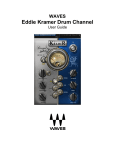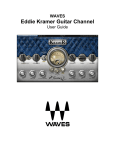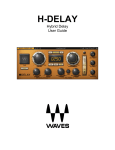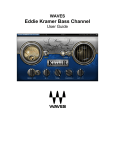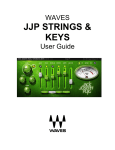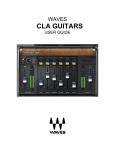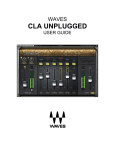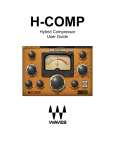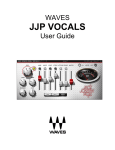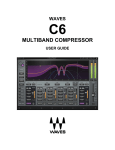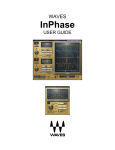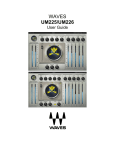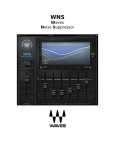Download Vocal Rider User Manual
Transcript
Waves VOCAL RIDER User Guide TABLE OF CONTENTS Chapter 1 – Introduction .......................................................................................3 1.1 Welcome......................................................................................................3 1.2 Product Overview ........................................................................................3 1.3 Concepts and Terminology..........................................................................4 1.4 Components ................................................................................................4 Chapter 2 – Quickstart Guide ...............................................................................5 Chapter 3 – Interface and Controls .......................................................................6 3.1 Interface.......................................................................................................6 3.2 Controls .......................................................................................................7 Chapter 4 – The WaveSystem ............................................................................12 4.1 The WaveSystem Toolbar .........................................................................12 4.2 Preset Handling .........................................................................................12 4.3 Interface Controls ......................................................................................14 Waves Vocal Rider User Guide 2 Chapter 1 – Introduction 1.1 Welcome Thank you for choosing Waves! In order to get the most out of your Waves processor, please take the time to read through this manual. In conjunction, we also suggest you become familiar with www.wavesupport.net. There you will find an extensive Answer Base, the latest Tech Specs, detailed Installation guides, new Software Updates, and current information on Authorization and Registration. By signing up at www.wavesupport.net, you will receive personalized information on your registered products, reminders when updates are available, and information on your authorization status. 1.2 Product Overview Vocal Rider is the first of Waves pioneering new series of Mix tools. As its name implies, it automatically rides vocal track levels. Instead of manually riding a mixing console fader, or tediously drawing in every level change on a DAW track, Vocal Rider does it for you, making it a true timesaver. All you need to do is set the target range of the vocal level in relation to the rest of the mix. Then, Vocal Rider adjusts the level so it stays within your target, raising or lowering the vocal volume, in real-time. And unlike compression, Vocal Rider doesn’t add any additional coloring to your track. From the recording studio to the concert stage, from the broadcast studio to the post house, Vocal Rider takes mixing to the next level. Keep consistent vocal & dialog levels automatically. Steady vocal levels without affecting their sound. Achieve an open-sounding mix by avoiding over-compression. Real-Time means zero latency and no pre-scan needed. Intelligently adjusts vocal level based on dynamics of the music tracks. Write the automatic riding to an automation track for fine tuning. Waves Vocal Rider User Guide 3 1.3 Concepts and Terminology The vocal production process can be divided into several stages: recording, comping, mix positioning, sound character adjustment (Dynamics/EQ/Effects), and gain riding. Vocal gain riding is the final stage, during which the vocal level is fine-tuned by making small changes to its playback level, to make its position in the mix consistent throughout the song. Vocal Rider splits the elements of the mix into two main components: vocals and playback. • • Vocal: All vocal tracks, with or without effects (as defined by the user) Music: The rest of the mix, minus the vocal tracks 1.4 Components WaveShell technology enables us to split Waves processors into smaller plug-ins, which we call components. Having a choice of components for a particular processor gives you the flexibility to choose the configuration best suited to your material. Waves Vocal Rider includes four components: • • • • Vocal Rider Mono Vocal Rider Stereo Vocal Rider Live Mono Vocal Rider Live Stereo Waves Vocal Rider User Guide 4 Chapter 2 – Quickstart Guide Insert Vocal Rider as the last plug-in on your vocal or vocal group track. Send your instrumental tracks, post fader, to a bus, just like a headphone mix. Set the sidechain input on Vocal Rider to the instrumental bus. Begin playing your song, then set the Vocal Sensitivity and Attack controls. Set the Target control by moving the transparent screen to the Vocal range peak. The main Rider fader will begin to move automatically, leveling your vocal. In Live situations, if the fader moves when no vocal signal is present, adjust the Spill control to differentiate unwanted ambient stage noise, for better tracking. Limit the amount of automatic gain change by setting the range faders. To correlate the vocal level to the instrumental level, adjust Music Sensitivity. Arm your host to write automation, then Press Automation Write at any time to send the Vocal Rider Fader to your host application automation edit lane, make your manual edits, and then press Read. Using your ears, find the sweet spot and trim using the output fader. Waves Vocal Rider User Guide 5 Chapter 3 – Interface and Controls 3.1 Interface Waves Vocal Rider User Guide 6 3.2 Controls TARGET sets the reference range for vocal mix positioning. Since Gain Riding is relative to the Target position, changing the Target setting will move the Rider Fader’s ‘0’ calibration, re-focusing the correct level range. Range: 0 to -42 dBFS Default: -21 SPILL differentiates between vocal signal and unwanted ambient stage noise, to provide better tracking. (Vocal Rider Live components only) Range: -12 to -48 dBFS Default: -48 VOCAL SENSITIVITY controls the vocal detector sensitivity, which differentiates vocal content from noise floor, spill, and ambience, and identifies the beginnings and endings of words. Range: -12 to +12 dB Default: 0 VOCAL ACTIVITY DISPLAY indicates when vocal activity is detected. Range: Ride, Idle Default: Idle Waves Vocal Rider User Guide 7 ATTACK sets the vocal detection attack behavior, affecting both detection timing and fader riding speed. Range: Fast, Slow Default: Slow MUSIC SENSITIVITY determines the amount Vocal Rider adapts to changes in instrumental levels. (“Instrumental” refers to all tracks other than the vocal). Range: -12 to +12 dB Default: 0 Please note: To use this control, the instrumental mix bus must be assigned to the Vocal Rider side-chain input. MUSIC SENSITIVITY LED indicates when and how much Vocal Rider is affected by instrumental levels. Range: Soft Green to Bright Green When the LED is soft green, vocal riding is less affected by instrumental level; as vocal riding is more affected by the instrumental level, the LED gets brighter. Please note: To use this control, the instrumental mix bus must be assigned to the Vocal Rider side-chain input. Waves Vocal Rider User Guide 8 RANGE MIN sets the lower boundary of the Rider Fader movement range, setting the maximum possible Rider Fader attenuation. Range: -12 to +11 dB Default: -6 RANGE MAX sets the upper boundary of the Rider Fader movement range, setting the maximum Rider Fader gain. Range: -11 to +12 dB Default: +6 IDLE ARROW sets the Rider Fader value when there is no vocal activity. Typically, it is in the middle of the range, to avoid drastic gain changes between words. Range: -12 to +12 Default: 0 Waves Vocal Rider User Guide 9 EFFECTIVE RANGE displays the total gain range available for automatic riding. Range: 1 to 24 dB Default: 12 RIDER FADER is Vocal Rider’s automatic control, which moves according to the internal detectors’ algorithm to level-out the vocal, similar to manual fader riding. (The TARGET control is used to set the Rider Fader ‘0’ calibration.) Range: -12 to +12 dB Default: Idle value If touched by the mouse, the Rider Fader allows manual gain adjustment. Once the mouse is released, the Rider Fader will continue automatic riding. When using a control surface to manually override the Rider Fader, press the control surface’s Manual button, then begin riding. Waves Vocal Rider User Guide 10 AUTOMATION MODE controls the Rider Fader operation. When set to Off, the Rider Fader will use its internal engine and will not send out nor read automation. Range: Off, Write, Read Default: Off When set to Write, all Rider Fader movements are sent to the host application automation lane. (DAW host automation must be enabled in write/touch/latch mode, and the Rider Fader must be armed for automation). Though the Rider Fader moves automatically, it is treated by the host application as if automation is being written manually. When set to Read, the Rider Fader uses the automation lane to define its movement, disregarding Vocal Rider’s internal engine. OUTPUT trims the vocal output gain, post-auto riding; the CLIP LED shows when output is clipping. Range: -12 to +12 dB Default: 0 Waves Vocal Rider User Guide 11 Chapter 4 – The WaveSystem 4.1 The WaveSystem Toolbar All Waves processors feature the WaveSystem toolbar which takes care of most administrative functions you will encounter while working with your Waves software. The features of the WaveSystem toolbar are the same on practically all Waves processors, so familiarity with its features will be helpful whichever processor you are using. Toolbar Functions Undo Redo Setup A/B Copy A->B Load Save ? Undoes the last 32 actions. Redoes the last 32 undone actions. Toggles between two presets. This is useful for close comparison of different parameter settings Copies the current settings to the second preset register Recalls presets from file Saves presets in the Waves file formats Opens the manual for the processor you are using 4.2 Preset Handling Preset Types Factory Presets are permanent presets in the Load menu. Factory presets cannot be over-written or deleted. When applicable, different component plug-ins may have different factory presets. User Presets are your favorite settings of the plug-in saved as a preset in the Load menu, under ‘User Presets’. User Presets can be over-written and deleted. Setup Files may contain more than one preset. For example, a single file can contain all the presets for a session. When you open a Setup File, all its setups become part of your Load pop-up menu for fast access. This can be particularly useful with multiple instances of a plug-in in a single session. By saving all the settings you create into a single Setup File, they can all be quickly available for every instance of that plug-in. Waves Vocal Rider User Guide 12 Loading Presets and Setups Click-and-hold on the Load button to see the Load pop-up menu. The menu is divided into four sections. If a section is not currently available it will not appear in the Load popup menu. Open Preset File… Select to open any setup or preset file, whether from the Library or your own creations. ‘Filename.xps’: Displays any currently loaded Setup File and its presets. Factory Presets: Displays the default Factory Presets. User Presets: Displays any loaded User Presets. Saving Presets and Setups Click-and-hold on the Save button to see the Save pop-up menu. Four options are available. If an option is not currently available it will be grayed out and inaccessible. Save to New File… Select this to start a new Setup file. There are two prompts - first for the setup filename, then for the preset name. You must provide a name for both the setup file and the preset. Click OK (ENTER) to complete the save. It is a good idea to create a folder in which to save several setup files for a project. Save ‘File Name’ – “Preset Name” Overwrites the settings of the loaded preset (whether a User Preset or a preset from a Setup File) with the current settings. If a Setup File is currently loaded, the name of the Setup File is displayed followed by the name of the preset itself. If a User Preset is loaded, its name is displayed. Save to ‘File Name’ As… Saves the current settings as a new preset into the Setup file that is open (if one is not open, the option is grayed out). You will be prompted to give the preset a name. Put into Preset Menu As… Save the current settings into a User Preset that will always be in your Load menu (until deleted). You will be prompted to give this preset a name. User Presets are stored in the plug-in’s preference file. Waves Vocal Rider User Guide 13 Deleting Presets You may delete User Presets and presets within a Setup File. Factory Presets and Setup Library files cannot be deleted or overwritten. 1. Hold the Command (Mac)/Control (PC) key down. 2. Click-and-hold the Load button to see the pop-up menu. 3. While still holding the Command/Control key, select the preset or setup to delete. 4. A confirmation box will appear, allowing you to cancel or ‘OK’ the deletion. A/B Comparison and Copying The Setup A/Setup B button may be clicked to compare two settings. If you load a preset in the Setup B position, this will not affect the preset loaded into the Setup A position, and vice-versa. If you want to slightly modify the settings in Setup A, you can copy them to Setup B by clicking on the Copy to B button, then alter Setup A and compare with the original Setup B. The name of the current setup will be shown in the title bar (on platforms which support it), and will switch as you change from Setup A to Setup B. Note: an asterisk will be added to the preset name when a change is made to the preset. 4.3 Interface Controls Controls can be in one of three states: • • • Not Selected where the control is not the target of any user entry Selected where the control is the target of mouse control entry only Selected and Active where the control is the target for both mouse and keyboard entry Toggle Buttons Toggle buttons display the state of a control, and allow switching between two or more states. Single-click to change the control’s state. Some toggle buttons have a text display which updates with the current setting, and others (bypass, solo, or monitoring toggles) illuminate when the control is active. Some processors have link buttons between a pair of toggle buttons, allowing clickand-drag adjustment while retaining the offset between the controls. Waves Vocal Rider User Guide 14 Value Window Buttons Value windows display the value of a control and allow click-and-drag adjustment, or direct control via the keyboard. • • • Using the mouse, click-and-drag on the value window to adjust. Some value windows support left/right, some up/down (as you hover over a button, arrows will appear to let you know which direction of movement that button supports). Using the arrow keys, click once with mouse to select the button, and then use up/down – left/right (depending on the direction supported by that button) to move in the smallest incremental steps across the button’s range (holding down the arrow keys will move faster through the range). Using key entry, double click on the button to open the value window, and directly enter the value from your keyboard. If you enter an out of range number, the button stays selected but remains at the current setting (system beeps? If system sounds are on?) Some processors have link buttons between a pair of value windows, allowing clickand-drag adjustment while retaining the offset between the controls. Sliders Click on the slider itself or anywhere within the slider’s track. The numerical value of the slider settings is displayed in a hover window above the slider path. Hover Box Hovering boxes will appear and display the control value when hovering with the mouse over the control. TAB Functions TAB moves the ‘selected’ status to the next control, with shift-TAB moving in the reverse direction. Additionally, the Mac has an option-TAB function for ‘down’ movement and shift-optionTAB for ‘up’ movement where applicable. If you have several Value Window Buttons selected, TAB functions will take you through the selected controls only. Waves Vocal Rider User Guide 15















